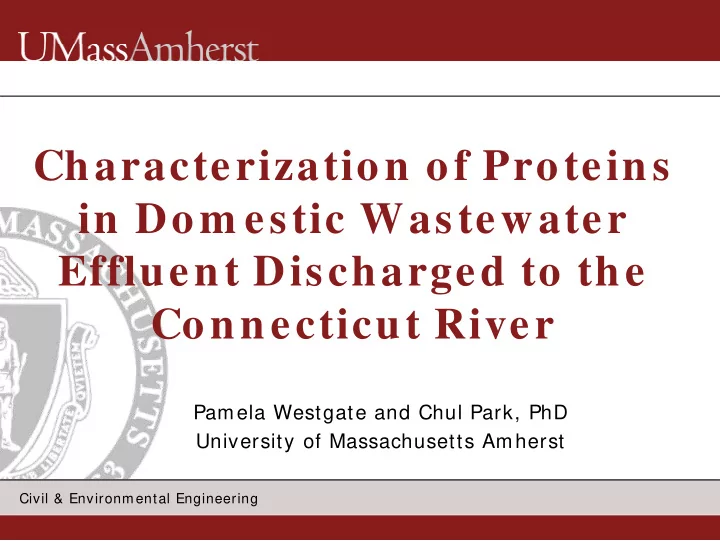

Characterization of Proteins in Dom estic Wastewater Effluent Discharged to the Connecticut River Pamela Westgate and Chul Park, PhD University of Massachusetts Amherst Civil & Environmental Engineering
Outline 1) Wastewater Treatment Plant 2) Regulatory Water Quality Parameters for Effluent 3) Water Quality Issues 4) Research 5) Future Work Civil & Environmental Engineering 2
Wastewater Treatment Plant Schematic SecondaryC Primary Aeration Basin larifier Clarifier Influent Effluent BOD TSS Return Activated Sludge Coliforms Waste Activated Sludge Nitrogen Sludge Civil & Environmental Engineering 3
Regulatory Water Quality Effluent Parameters � BOD = Biological Oxygen Demand • 5-day test, measure dissolved oxygen (DO) before & after • higher BOD means higher oxygen demand from effluent � TSS = Total Suspended Solids • can carry micro-organisms and organics � Coliform Bacteria • indicate pathogenic organisms � Acute toxicity tests • twice per year • Ceriodaphnia dubia Civil & Environmental Engineering 4
5 Water Quality Parameters - NPDES Permit Civil & Environmental Engineering
6 Water Quality Parameters - NPDES Permit Civil & Environmental Engineering
Water Quality Issues � Long Island Sound Study • eutrophication in summer huge problem • early 1990s – approx. 60% Nitrogen load from POTWs � 12 POTWs discharge directly to CT River in Massachusetts � 127 MGD permitted flow � 8,900 lbs Nitrogen released per day assuming effluent concentration of 10 mg/ L TN Civil & Environmental Engineering 7
Water Quality Issues Nitrogen - + NO 2 - + organic N TN = NH 3 + NO 3 TKN = NH 3 + organic N Civil & Environmental Engineering 8
Nitrification / Denitrification � Nitrification: - NH 3 + O 2 NO 2 - + O 2 - NO 2 NO 3 � Denitrification: - - + H 2 NO 3 NO 2 O - NO 2 NO + H 2 O NO N 2 O + H 2 O N 2 O N 2 ( g) + H 2 O Civil & Environmental Engineering 9
Research - Organic Nitrogen � Dissolved organic nitrogen (DON) is Persistent • Free amino acids • Combined amino acids (Proteins) • Humic acids • amino acid fragments • other N-containing organic matter • EDTA • NDMA precursors Civil & Environmental Engineering 10
Research - Proteins � What proteins are in the effluent from POTWs? • are they from influent? • are they from secondary treatment? � Are they bio-available? When? � Are there active enzymes in the effluent? • if so, how do they interact with the riverine environment? � Proteins are difficult to measure • proteomics allows us to learn more about proteins Civil & Environmental Engineering 11
Research - Proteomics Developed in Biology and Genetics: � The study of the expression, location, functions, and interactions of proteins in a cell or organism. Applied to an ecosystem (wastewater): � The study of the presence, activity, and interactions- the fate and transport of proteins in an environment. Civil & Environmental Engineering 12
Research- Tools of Proteomics � SDS-Page • sodium dodecyl sulfate polyacrylamide gel electrophoresis • separate protein fragments by size on gel • stain gel or protein fragments to visualize � Zymography • gel infused with proteins (casein, gelatin) • separate proteins on gel • incubate and stain • areas of gel with active enzymes won’t stain � Mass-spectrometry • Measures protein mass Civil & Environmental Engineering 13
14 2 ° (0.45µm) Research – Recalcitrant Proteins 2 ° PS 1 ° Civil & Environmental Engineering
15 0.45µm 2° Research – Recalcitrant Proteins 2° 1 ° Civil & Environmental Engineering
16 Research – Proteins Generated in Secondary Treatment 0.45µm 2° 2° 1 ° Civil & Environmental Engineering
17 2 ° (0.45µm) Research – Some Proteins Removed 2 ° PS 1 ° Civil & Environmental Engineering
Research – 0.45µm Filter Removes some Proteins 2 ° 2 ° PS 1° 0.45µm Civil & Environmental Engineering 18
19 2° (0.45) 2° A N Research – Active Enzymes 2° N Civil & Environmental Engineering
Research – Parameters Measured � Protein quantity and fragment patterns � Enzyme activity � TSS/ VSS � COD � TN � TP � ammonia, nitrate, nitrite (IC) Civil & Environmental Engineering 20
Research - Conclusions � Significant amount of proteins and organic N are transported to the CT River in POTW effluents. � Some influent proteins persist and pass through secondary treatment processes. � Some proteins generated during secondary treatment are released in the effluent. � High level filtration (0.45µm) does not remove many of these proteins. � Some effluent proteins are active enzymes. Civil & Environmental Engineering 21
Future Research Short term: � Continue to expand data set through collection & processing of samples � Refine mass balance of proteins � Identify protein bands of interest with mass spectrometry Civil & Environmental Engineering 22
Future Research This summer: � Expand mass spectrometry data set of effluent protein to create a mass ‘fingerprint’ from each plant. � Laboratory bioassays – characterize proteins in effluent before and after incubation with receiving water to evaluate the bioavailability of effluent proteins. � Field study - monitor the fate of proteins in the receiving water using proteomic datasets. Civil & Environmental Engineering 23
Acknowledgements � Civil & Environmental Engineering Department � Perrell Research Endowment for Environmental Engineering � MA Water Resource Research Center Civil & Environmental Engineering 24
Recommend
More recommend